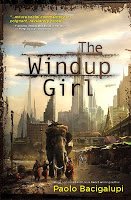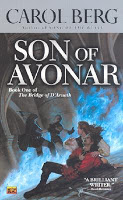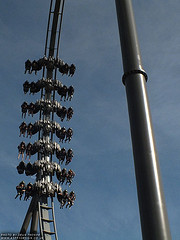But when you begin reading, you may not be aware that the book contains graphic scenes of rape and torture.
Uncomfortable Fiction
Before we examine rape and torture in literature, let me first say: Good fiction does tend to make us uncomfortable. It takes us out of our comfort zones and makes us think. Science fiction and fantasy in particular make us consider the big “What If?” questions.
 |
| The Swarm roller coaster by Aspex Design / Dean Thorpe | Flickr |
We imagine what it’s like to live in the 1700s, to be the unfairly ostracized member of the family, to be the first human to encounter aliens, to experience life as an immortal, to be the most powerful… and the most powerless.
How does fiction do this? By putting us on the front seat of the roller coaster — with viewpoint characters. Through fiction we live a thousand vicarious lives.
Literary scholars and readers alike have remarked on how glorious the act of reading is, that we can experience all these things from the comfort of an armchair.
But a book is not a static object. It’s a dynamic world, alive within us. So what happens if that world is a dystopia, or if the land is torn apart through magic, or if the viewpoint character, who is the surrogate for the reader, is killed?
My Preferred Genres
Before I go on, I should mention that my preferences fall heavily in the speculative fiction genre. I’ll read books and watch movies in just about any subgenre in science fiction and fantasy.
But I don’t like horror. And I may watch a romantic comedy, but it’s rare that I’ll edge into reading romance, even if it could be considered SF or fantasy, i.e. paranormal romance. I also haven’t found much urban fantasy I’ve enjoyed. And literary fiction is 100% dead to me.
Why don’t I read those genres? The easiest answer is that I don’t like the way they make me feel.
Horror fills me revulsion or terror… and my paranoid imagination is well-oiled already, thanks. Romance feels manipulative, and if reading is truly a collaboration between the writer and the reader, then romance is way too intimate for my tastes. Literary fiction never seems to take me anywhere interesting…
I hope that gives some context to the rest of this post.

Spoiled Stories
Beware! I’m about to spoil most of The Windup Girl by Paolo Bacigalupi, the first 100 pages of Lord Foul’s Bane of the Thomas Covenant series by Stephen R. Donaldson, much of the Son of Avonar book of the Bridge to D’Arnath series by Carol Berg, the beginning of Daughter of the Blood of The Black Jewels trilogy by Anne Bishop, and some of The Warded/Painted Man by Peter V. Brett.
There are others I could have remarked on, such as A Song of Ice and Fire series by George R. R. Martin and The Symphony of Ages series by Elizabeth Haydon. But this post is long enough!
Spoilers below!
Scenes of Rape and Torture
I’ve most recently read The Windup Girl, so we’ll start there. We don’t meet the windup girl until Chapter 3, which is where we also first see her raped — from her viewpoint. It’s made clear that this is nothing new, the patrons don’t consider her a human, and her humiliation is nothing more than entertainment.
Now, plenty of books try to introduce the violence of the world early so that you know what you’re getting yourself into later on. It acts as a signpost. Turn back now if you can’t handle this, it reads.
Daughter of the Blood starts out with a horrible act of torture in Chapter 1, in which the leader of a slave revolt is locked up and helpless as rats eat into his privates.

Son of Avonar starts out bleak and continues to grind the reader into depression all the way through to the inevitable torture scene in the middle of the book. And yet you get the sense there’s something else going on here, something that will make the unrelenting ominous nature of the book worthwhile.
But other books are not kind enough to warn their readers of the impending violence.
In Lord Foul’s Bane, Thomas Covenant is transported to a different world where he is no longer a leper. Certainly there is suffering in the first chapters of the book, but in Chapter 7 Covenant abruptly rapes a young virgin girl who has treated him with nothing but kindness, acting as his guide. (Not that there would have been any justification regardless, but in contrast with her virtue, the rape is deeply disturbing.)
Many readers stop at that point and never get around to reading the rest of the Convenant series. I did too. Why would I want to read a series in which the main character is a rapist? That’s taking the definition of anti-hero a little too far. The main character is supposed to be someone we’re interested in watching, and although he doesn’t have to be sympathetic, it’s hard to care what happens to him if you have no respect for his character any longer.
Why the Graphic Violence?
Generally, rape and torture in fiction serves to further the plot or show character development. For instance, in The Windup Girl, Emiko is reshaped by the daily humiliation she is forced to suffer. She overcomes the programming written into her very being as a windup — her DNA — and slaughters a roomful of men.
 |
| Violences — Erminig Gwenn / Etienne Valois | Flickr |
However, I would argue it wasn’t necessary for the reader to have to see an additional scene of debasement before her transformation. The rape is again described in horrifying detail, leaving me feeling dirty just for touching the book.
What really bothers me, though, is when there doesn’t seem to be a purpose to the violent act. The best example I can think of this is in The Warded/Painted Man. The viewpoint character watches his female traveling companion being accosted by highwaymen. He knows what they are about to do but is helpless to stop it. They knock him unconscious, and when he wakes up, he sees the results.
So although I appreciated not having to witness the girl’s humiliation in that scene, it didn’t seem to serve much of a purpose in the larger scale of things. Instead, it distanced me from the book, because (if I recall correctly) it’s only a day or two later that the girl beds down the the warded man. Unrealistic, if she’d just been violently raped a few days before.
The Effect on the Reader
(The debate has raged on about whether violence in books, movies, and video games desensitizes people to violence, or makes them more aggressive. So enough has been said on that topic. I’m more interested in how it affects a reader’s enjoyment of the book.)
Plenty of readers, literary critics, and authors alike have reflected on why we read and how it affects us as people. Through reading, we vicariously learn about others’ experiences, even if those experiences are fictional.
Fiction gives us a chance to imagine how scenarios could turn out in the playgrounds of our minds. This may be one reason why other types of graphic violence (in a battle scene, for instance), don’t disturb me at all.
Studies have also shown that reading causes us to take the experiences in the books into ourselves, which is why violence in fiction can be so disturbing. When the reader and writer have jointly shaped the world, a disturbingly graphic scene can make the reader feel like screaming, “How could you do this to me?”
As in Lord Foul’s Bane, a graphic scene sometimes knocks me completely out of the story, making me feel angry at the author for planting those thoughts in my head. The reader falls back into the real world, and the story is shattered.
So I would also say graphic rape and torture also tend to make me less likely to seek out books by that author again. Although I loved the world of The Warded Man, I’m on the fence about reading The Desert Spear. I’m a little leery of Paolo Bacigalupi’s work right now as well.
On the other hand, if the payoff is big enough, I may read the rest of a series, as in the case of The Son of Avonar.
Have you ever stopped reading a book because a scene was too graphic? Did you pick up other books by that author again? What kinds of scenes are “deal-breakers” for you?
Leave a comment below or take the poll. You can also read the rest of my review of The Windup Girl on Goodreads.

Comments
7 responses to “Rape and Torture in Fiction”
Traci, I wanted to try a comment from my phone to see if it works ok. I like that you have added pictures to your commentary. I didn't finish the article yet but it does make me squirm a little when I encounter bad moments in a story. I can't wait to read your novel! Love, Mom
I did respond yes about putting down a book because of the violence and whether the violence bothered me, but I want to elaborate.
As an example, I decided to read the Dexter series and a couple of times had to put down the books because of the violence. But it wasn't because I was turned off by the series. It was because it was so scary, I couldn't sleep at night. That, to me, is a sign of a well written book.
I really enjoyed this post. It gave me several discussion topics or at least positions to think through.
I read more of Thomas Covenant, but I never liked it and I never liked him. That scene just killed all my interest in him.
I felt very much the same about The Windup Girl. Was it really necessary to be that graphic? I got through the first Chronicles of Thomas Covenant series, but couldn't read the second which I seem to remember has torture of children at the beginning.
I haven't read any of the female authors you mention. I wonder do you find that they handle the scenes differently?
CAUTION: Spoilers ahead for the game “The Last of Us.”
I read the first trilogy of the Thomas Covenant series, but refused to take it any further. I understand in a purely analytical context that the rape scene was intended to demonstrate that Covenent was an anti-hero, and everything he did from there on was to be viewed through that filter.
I had very similar feelings in the last reel of “The Last of Us” where Joel kills the surgeon who was very likely the only person in the world at that point who could save humanity. It’s as if Naughty Dog wanted to rub our noses in the fact that Joel is an ant-hero. I had to play that final battle several times trying to find a way to avoid killing the surgeon before giving up with the realization that there is simply no way to do it. Then Joel makes it worse by killing Marlene, probably the only person in the universe who could sympathize with what he felt towards Ellie.
It’s a lot easier to deal with violent villains than violent anti-heroes, at least in a psychological context.
Agreed! And that’s frustrating they made it impossible to change the outcome of Joel’s actions. If you can’t change the narrative, then it may as well be a book or a movie, not a video game!
I think that, as a writer, you are more of a witness than anything else. You discover your characters, and eventually realize something really wrong happened to one of them, for the simple reason that God awful batshit crazy things happen all the time for no reason at all. They just do. Follow one chimp or baboon for a month, and you’ll see more horror than you’ve read in your life. And that’s about it. If you have a sick villain in a story, he must be so because…? How do you justify human perversion?
If you mean for the reader to see what you see, there isn’t a plethora of ways to do so. Sure, there are loads of brilliant literary works out there that are contempt to introduce evil as being evil, like everyone has the notion that evil is what it is, like it’s just crawling out of hell as such and lives on in a pictured world as such.
But the boundary between what is wicked and what is righteous is somewhat loose, and the most common driving force to stretch it, bounce across it, fade it is trauma. Trauma can be a tricky matter of perception (leading to fine literature) or just blund plain rape or torture.
Some people talk of “gratuitous rapes” or whatever fancily disguised femen angry word you want you name it, as “a silly paragraph that only attempts to shock the reader and is totally unnecessary to the plot”. But if the narrator is on his way to the tube and walks on a gang-rape, the fact that she sees it and acknowledges it is part of the plot. She steps in, up or out of the event and lives with the choice she made.
I end up ranting a short outrage that no one shall ever read in all anonymity because as we grow as a civilization and as a race, people delude themselves by truly believing that seemingly so expands our tolerance and consciousness. But all I see is censorship severing and empathy shrinking. Like not looking at the big dung under your foot somehow makes it disappear, and by boycotting rape scenes you show sympathy to rape survivors, but you don’t. You first further shame them and then smooth out the horror of the deed, or just look the other way.
Reading a lengthy detailed gruesome scene is not meant to be pleasing, entertaining or a source of discomfort. It simply testifies a factual or fictional perceived event. Should you feel anger disgust or arousal, it’s up to your sick mind. It says more about you than it says about the story or the author. The perceived emotions experienced by the character is however written as to offer insight into the character’s idiosyncrasy and to further develop the story’s web as it is witnessed by the author, nothing more and nothing less.
Having the narrator commiting torture or a rape spirals the reader within the narrator’s psyche, and if you stop your reading after the deed, you miss out on the narrator’s fate and are left reflecting on your own deed, the deed that you committed, a deed that you ended up making your own, which is a mistake as a reader. You are not the narrator, you’re just a witness, as is the writer.
Biting on your feelings as a witness, therein lies the witness’s duty. Only then can you grow as a person. But we agree, you can sometimes feel abused as a person by the author, and it is your opportunity as a scientent being to grow your sense of tolerance and primarily to learn more about the person you are.